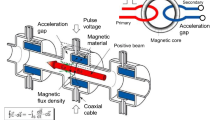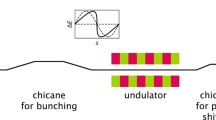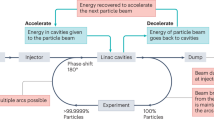Abstract
SEVERAL methods have been suggested1,2,3 for using disturbing magnetic fields to eject an electron beam from a synchrotron or betatron. Important differences exist in these methods in the angular distribution of these disturbing fields. Thus the 'orbit expansion' method1,2 effectively applies a sudden decrease of field over the whole 360° of annulus, while the '+ field' method3 decreases the field over 180° of annulus, while increasing it over the other 180°. The considerations outlined in this communication lead to the suggestion of an 'optimum step field', that is, a disturbing field of angular length such that the required beam displacement is obtained with minimum reactive power in the ejector field coil.
This is a preview of subscription content, access via your institution
Access options
Subscribe to this journal
Receive 51 print issues and online access
$199.00 per year
only $3.90 per issue
Buy this article
- Purchase on Springer Link
- Instant access to full article PDF
Prices may be subject to local taxes which are calculated during checkout
Similar content being viewed by others
References
Skaggs, Almy, Kerst and Lanzl, Phys. Rev., 70, 95 (1946). Kerst, Rev. Sci. Instr., 13, 387 (1942).
Crittenden and Parkins, J. Appl. Phys., 17, 444 (1946).
Clark, Getting and Thomas, Phys. Rev., 70, 562 (1946).
Author information
Authors and Affiliations
Rights and permissions
About this article
Cite this article
GOWARD, F., DAIN, J. Optimum Disturbing Field for Synchrotron Beam Ejection. Nature 159, 636–637 (1947). https://doi.org/10.1038/159636a0
Issue Date:
DOI: https://doi.org/10.1038/159636a0
Comments
By submitting a comment you agree to abide by our Terms and Community Guidelines. If you find something abusive or that does not comply with our terms or guidelines please flag it as inappropriate.



